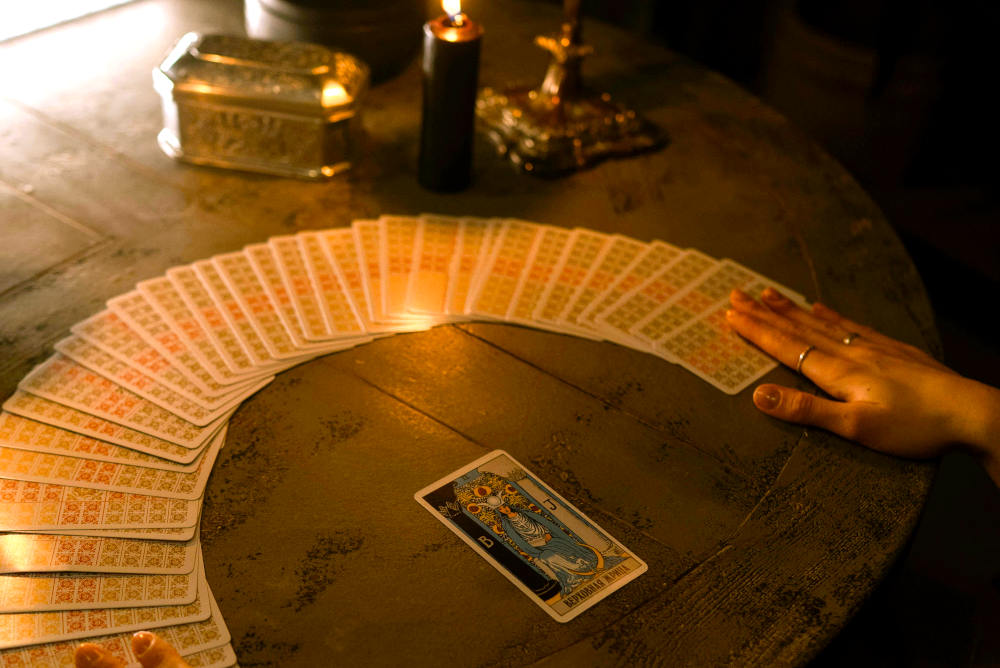
Long before tarot cards became the popular go-to for divination, ordinary playing cards were used to tell fortunes, offer guidance, and uncover hidden truths. This practice—known as cartomancy—has been around for centuries and is still used today by those who prefer a simpler or more discreet alternative to tarot.
If you’ve ever wondered how to turn your standard deck of 52 playing cards into a powerful spiritual tool, you’re in the right place. In this article, we’ll explore the history of cartomancy, the meaning of each card, common spreads, and practical tips to start reading playing cards just like a tarot deck.
Panaprium is independent and reader supported. If you buy something through our link, we may earn a commission. If you can, please support us on a monthly basis. It takes less than a minute to set up, and you will be making a big impact every single month. Thank you!
A Brief History of Cartomancy
Cartomancy is the art of fortune-telling or divination using a deck of playing cards. It dates back to at least the 14th century, shortly after playing cards were introduced to Europe. While tarot cards evolved into their own rich symbolic system, many seers and fortune-tellers continued using ordinary playing cards for readings—especially when tarot decks were less accessible or culturally taboo.
In fact, in many parts of Europe and the Americas, playing card readings were the preferred method of divination well into the 19th century, used by traveling Romani readers, mystics, and even royal advisors.
Why Use Playing Cards Instead of Tarot?
There are several reasons why people might choose playing cards for divination:
-
Accessibility: Almost everyone has a deck of playing cards lying around.
-
Discretion: In cultures or families where tarot is frowned upon, playing cards are more socially acceptable.
-
Simplicity: With fewer cards and less artwork, readers can focus more on intuition and number/suit meanings.
-
Tradition: Cartomancy is a respected historical practice in its own right.
Understanding the Deck: Playing Cards vs. Tarot
A standard deck of playing cards has 52 cards divided into four suits:
-
Hearts
-
Diamonds
-
Clubs
-
Spades
Each suit contains cards numbered Ace through 10, plus Jack, Queen, and King. Unlike tarot, playing cards do not include the 22 Major Arcana or the Page card.
Here’s how they roughly compare to the Minor Arcana in tarot:
| Playing Cards | Tarot Equivalent | Suit Meaning |
|---|---|---|
| Hearts | Cups | Emotions, relationships, love |
| Diamonds | Pentacles/Coins | Money, work, material life |
| Clubs | Wands | Action, ambition, creativity |
| Spades | Swords | Intellect, conflict, struggle |
The court cards—Jack, Queen, and King—are directly comparable to the tarot’s Knight, Queen, and King. The Page in tarot is often merged with the Jack in cartomancy.
The Meaning of Each Suit
Understanding the elemental and symbolic meanings behind each suit is the foundation of reading playing cards.
1. Hearts – Emotions & Relationships
-
Connected to the element of Water
-
Represents love, compassion, family, friendship, and emotional well-being
-
Think of it as the "heart" of the matter—your feelings and personal life
2. Diamonds – Finances & Material Concerns
-
Linked to the element of Earth
-
Symbolizes wealth, work, possessions, physical health, and ambition
-
Concerns the practical side of life: career, money, and status
3. Clubs – Action & Growth
-
Associated with the element of Fire
-
Stands for passion, creativity, communication, and progress
-
Related to your goals, energy, and personal power
4. Spades – Challenges & Intellect
-
Tied to the element of Air
-
Represents thinking, communication, adversity, and change
-
Often signals conflict, mental strain, or life lessons
Card Number Meanings
Each number holds symbolic weight, much like in numerology or tarot:
-
Ace: Beginnings, potential, energy
-
Two: Balance, partnership, duality
-
Three: Growth, expansion, creativity
-
Four: Stability, foundation, structure
-
Five: Conflict, change, instability
-
Six: Harmony, cooperation, recovery
-
Seven: Reflection, mystery, challenge
-
Eight: Power, movement, strength
-
Nine: Near completion, wisdom, fulfillment
-
Ten: Completion, endings, transition
Court Card Interpretations
-
Jack: A youthful person, messenger, or new opportunity. Often immature or learning.
-
Queen: A nurturing, intuitive figure. Represents emotions, care, or inner knowledge.
-
King: Authority, leadership, mastery over the suit’s qualities.
When court cards appear in a spread, they can refer to people, roles, or aspects of yourself depending on context.
Jokers in Cartomancy
Not all playing card decks include Jokers, but if yours does, you can use them creatively:
-
Joker as The Fool: Represents unpredictability, freedom, new journeys, or wild cards.
-
Some readers use black Joker as chaos or warning and red Joker as surprise blessings.
In traditional cartomancy, Jokers were not always used, so their interpretation is flexible.
How to Prepare Your Deck
Before doing a reading, follow these steps:
-
Cleanse the Deck: Knock on the deck, shuffle thoroughly, or place a crystal over it.
-
Set an Intention: Focus your energy and ask your question aloud or silently.
-
Shuffle & Cut: Let intuition guide when to stop.
-
Draw Cards: Choose your spread or draw cards freely based on your question.
Common Spreads for Playing Cards
You can use many tarot spreads with playing cards. Here are a few beginner-friendly options:
1. Three-Card Spread
Ask a question and pull three cards:
-
Past – Present – Future
-
Situation – Challenge – Advice
-
Mind – Body – Spirit
2. Five-Card Cross
Draw five cards:
-
Center: Present
-
Top: Spiritual influence
-
Bottom: Earthly influence
-
Left: Past
-
Right: Future
3. Yes or No Reading
Pull an odd number of cards (3, 5, 7):
-
Count how many are red (Hearts or Diamonds) vs. black (Clubs or Spades)
-
More red = Yes, more black = No
-
Equal = Unclear or “ask again later”
Sample Card Interpretations
Let’s say you ask, “What should I know about my current relationship?” and draw:
-
10 of Hearts: Deep love or long-term commitment
-
7 of Spades: Mental tension or trust issues
-
Queen of Clubs: A passionate, social woman (could be you or a rival)
Interpretation: There's emotional depth in the relationship, but underlying mistrust or anxiety. The Queen could point to external influence or the need for better communication.
Tips for Beginners
-
Journal Your Readings: Write down the question, cards pulled, and your interpretation.
-
Start Small: Stick to 1–3 card spreads until you get confident.
-
Trust Intuition: Don’t rely solely on memorized meanings—let your gut guide you.
-
Learn from Patterns: Notice repeating numbers or suits and what they mean.
-
Don’t Fear “Bad” Cards: Spades and fives may seem negative, but they often highlight growth opportunities.
Combining Cartomancy with Other Tools
You can enhance your cartomancy practice by integrating:
-
Numerology: Add meaning based on personal numbers or life paths
-
Astrology: Assign planetary or elemental associations to each suit
-
Crystals or Pendulums: Use alongside cards for extra clarity
-
Dream Work: Ask questions about dream symbolism using the cards
Final Thoughts
Reading playing cards as tarot is not only possible—it’s historically authentic and spiritually enriching. You don’t need an expensive or esoteric tarot deck to begin your divination journey. A simple pack of 52 cards, your intuition, and a desire to explore will do just fine.
Whether you're reading for yourself or others, cartomancy offers clear, direct, and often surprisingly profound insight. Over time, as you build a personal connection with your deck, you’ll discover that the cards speak a language that’s both timeless and uniquely your own.
So next time you find a deck of playing cards in a drawer, don’t just think of poker or solitaire. Shuffle, ask a question, and let the cards reveal what lies beneath the surface.
Was this article helpful to you? Please tell us what you liked or didn't like in the comments below.
About the Author: Alex Assoune
What We're Up Against
Multinational corporations overproducing cheap products in the poorest countries.
Huge factories with sweatshop-like conditions underpaying workers.
Media conglomerates promoting unethical, unsustainable products.
Bad actors encouraging overconsumption through oblivious behavior.
- - - -
Thankfully, we've got our supporters, including you.
Panaprium is funded by readers like you who want to join us in our mission to make the world entirely sustainable.
If you can, please support us on a monthly basis. It takes less than a minute to set up, and you will be making a big impact every single month. Thank you.































0 comments